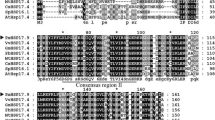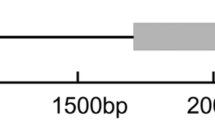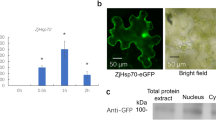Abstract
Nuclear-encoded chloroplast small heat shock proteins (Cp-sHSPs) play important roles in plant stress tolerance due to their abundance and diversity. Their functions in Primula under heat treatment are poorly characterized. Here, expression analysis showed that the Primula Cp-sHSP gene, PfHSP21.4, was highly induced by heat stress in all vegetative and generative tissues in addition to constitutive expression in certain development stages. PfHSP21.4 was introduced into Arabidopsis, and its function was analysed in transgenic plants. Under heat stress, the PfHSP21.4 transgenic plants showed increased heat tolerance as shown by preservation of hypocotyl elongation, membrane integrity, chlorophyll content and photosystem II activity (Fv/Fm), increased seedling survival and increase in proline content. Alleviation of oxidative damage was associated with increased activity of superoxide dismutase and peroxidase. In addition, the induced expression of HSP101, HSP70, ascorbate peroxidase and Δ1-pyrroline-5-carboxylate synthase under heat stress was more pronounced in transgenic plants than in wild-type plants. These results support the positive role of PfHSP21.4 in response to heat stress in plants.




Similar content being viewed by others
References
Barua D, Downs CA, Heckathorn SA (2003) Variation in chloroplast small heat-shock protein function is a major determinant of variation in thermotolerance of photosynthetic electron transport among ecotypes of Chenopodium album. Funct Plant Biol 30:1071–1079
Beyer WF, Fridovich Y (1987) Assaying for superoxide dismutase activity: some large consequences of minor changes in conditions. Anal Biochem 161:559–566
Bradford MM (1976) A rapid and sensitive method for the quantitation of microgram quantities of protein utilizing the principle of protein-dye binding. Anal Biochem 72:248–254
Charng YY, Liu HC, Liu NY, Chi WT, Wang CN, Chang SH, Wang TT (2007) A heat-inducible transcription factor, HsfA2, is required for extension of acquired thermotolerance in Arabidopsis. Plant Physiol 143:251–262
Chauhan H, Khurana N, Nijhavan A, Khurana JP, Khurana P (2012) The wheat chloroplastic small heat shock protein (sHSP26) is involved in seed maturation and germination and imparts tolerance to heat stress. Plant Cell Environ 35:1912–1931
Chen Q, Vierling E (1991) Analysis of conserved domains identifies a unique structural feature of a chloroplast heat shock protein. Mol Gen Genet 226:425–431
Downs CA, Jones LR, Heckathorn SA (1999a) Evidence for a novel set of small heat shock proteins that associates with the mitochondria of murine PC12 cells and protects NADH: ubiquinone oxidoreductase from heat and oxidative stress. Arch Biochem Biophys 365:344–350
Downs CA, Ryan SL, Heckathorn SA (1999b) The chloroplast small heat shock protein: evidence for a general role in protecting photosystem II against oxidative stress and photoinhibition. J Plant Physiol 155:488–496
Gill SS, Tuteja N (2010) Reactive oxygen species and antioxidant machinery in abiotic stress tolerance in crop plants. Plant Physiol Biochem 48:909–930
Guo SJ, Zhou HY, Zhang XS, Li XG, Meng QW (2007) Overexpression of CaHSP26 in transgenic tobacco alleviates photoinhibition of PSII and PSI during chilling stress under low irradiance. J Plant Physiol 164:126–136
Haq NU, Raza S, Luthe DS, Heckathorn SA, Shakeel S (2013) A dual role for the chloroplast small heat shock protein of Chenopodium album including protection from both heat and metal stress. Plant Mol Biol Rep 31:398–408
Heckathorn SA, Downs CA, Sharkey TD, Coleman JS (1998) The small, methionine-rich chloroplast heat-shock protein protects photosystem II electron transport during heat stress. Plant Physiol 116:439–444
Heckathorn S, Ryan SL, Baylis JA, Wang D, Hamilton EW, Cundiff L, Luthe DS (2002) In vivo evidence from an Agrostis stolonifera selection genotype that chloroplast small heat-shock proteins can protect photo-system II during heat stress. Funct Plant Biol 29:933–944
Jiang CH (2009) Cloning and functional analysis of RcHSP17.8 gene encoding a small heat shock protein in Rosa Chinensis. Dissertation, University of Fudan
Jiang C, Xu J, Zhang H, Zhang X, Shi J, Li M, Ming F (2009) A cytosolic class I small heat shock protein, RcHSP17. 8, of Rosa chinensis confers resistance to a variety of stresses to Escherichia coli, yeast and Arabidopsis thaliana. Plant Cell Environ 32:1046–1059
Kim KH, Alam I, Kim YG, Sharmin SA, Lee KW, Lee SH, Lee BH (2012) Overexpression of a chloroplast-localized small heat shock protein OsHSP26 confers enhanced tolerance against oxidative and heat stresses in tall fescue. Biotechnol Lett 34:371–377
Lea PJ, Blackwell RD (1993) Photosynthesis and production in a changing environment: a field and laboratory manual. Chapman and Hall, UK, pp 313–336
Lichtenthaler HK (1987) Chlorophylls and carotenoids: pigments of photosynthetic biomembranes. Meth Enzymol 148:350–382
MacAdam JW, Nelson CJ, Sharp RE (1992) Peroxidase activity in the leaf elongation zone of tall fescue. Plant Physiol 99:872–878
Marangoni AG, Palma T, Stanley DW (1996) Membrane effects in postharvest physiology. Postharvest Biol Technol 7:193–217
Maxwell K, Johnson GN (2000) Chlorophyll fluorescence––a practical guide. J Exp Bot 345:659–668
Osteryoung KW, Vierling E (1994) Dynamics of small heat shock protein distribution within the chloroplasts of higher plants. J Biol Chem 269:28676–28682
Pang CH, Li K, Wang BS (2011) Overexpression of SsCHLAPXs confers protection against oxidative stress induced by high light in transgenic Arabidopsis thaliana. Physiol Plant 143:355–366
Preczewski P, Heckathorn SA, Downs CA, Coleman JS (2000) Photosynthetic thermotolerance is positively and quantitatively correlated with production of specific heat-shock proteins among nine genotypes of tomato. Photosynthetica 38:127–134
Quan RD, Shang M, Zhang H, Zhao YX, Zhang JR (2004) Improved chilling tolerance by transformation with betA gene for the enhancement of glycinebetaine synthesis in maize. Plant Sci 166:141–149
Sanmiya K, Suzuki K, Egawa Y, Shono M (2004) Mitochondrial small heat-shock protein enhances thermotolerance in tobacco plants. FEBS Lett 557:265–268
Sato Y, Yokoya S (2008) Enhanced tolerance to drought stress in transgenic rice plants overexpressing a small heat-shock protein, sHSP17.7. Plant Cell Rep 27:329–334
Scarpeci TE, Zanor MI, Valle EM (2008) Investigating the role of plant heat shock proteins during oxidative stress. Plant Signal Behav 3:856–857
Shakeel S, Haq NU, Heckathorn SA, Hamilton EW, Luthe DS (2011) Ecotypic variation in chloroplast small heat-shock proteins and related thermotolerance in Chenopodium album. Plant Physiol Biochem 49:898–908
Shakeel SN, Haq NU, Heckathorn S, Luthe DS (2012) Analysis of gene sequences indicates that quantity not quality of chloroplast small HSPs improves thermotolerance in C4 and CAM plants. Plant Cell Rep 31:1943–1957
Sharom M, Willemot C, Thompson JE (1994) Chilling injury induces lipid phase changes in membranes of tomato fruit. Plant Physiol 105:305–308
Stewart GR, Robertson BD, Young DB (2004) Analysis of the function of mycobacterial DnaJ proteins by overexpression and microarray profiling. Tuberculosis 84:180–187
Tarantino D, Vianelli A, Carraro L, Soave C (1999) A nuclear mutant of Arabidopsis thaliana selected for enhanced sensitivity to light-chill stress is altered in PSII electron transport activity. Plant Physiol 107:361–371
Torok Z, Goloubinoff P, Horvath I, Tsvetkova NM, Glatz A, Balogh G, Varvasovszki V, Los DA, Vierling E, Crowe JH, Vigh L (2001) Synechocystis HSP17 is an amphitropic protein that stabilizes heat-stressed membranes and binds denatured proteins for subsequent chaperone-mediated refolding. Proc Natl Acad Sci USA 98:3098–3103
Ukaji N, Kuwabara C, Takezawa D, Arakawa K, Yoshida S, Fujikawa S (1999) Accumulation of small heat-shock protein homologs in the endoplasmic reticulum of cortical parenchyma cells in mulberry in association with seasonal cold acclimation. Plant Physiol 120:481–490
Valcu CM, Lalanne C, Plomion C, Schlink K (2008) Heat induced changes in protein expression profiles of Norway spruce (Picea abies) ecotypes from different elevations. Proteomics 8(20):4287–4302
Volkov RA, Panchuk II, Mullineaux PM, Schoffl F (2006) Heat stress-induced H2O2 is required for effective expression of heat shock genes in Arabidopsis. Plant Mol Biol 61:733–746
Wang D, Luthe DS (2003) Heat sensitivity in a bentgrass variant. Failure to accumulate a chloroplast heat shock protein isoform implicated in heat tolerance. Plant Physiol 133:319–327
Wang WX, Vinocur B, Shoseyov O, Altman A (2004a) Role of plant heat-shock proteins and molecular chaperones in the abiotic stress response. Trends Plant Sci 9:244–252
Wang YH, Ying Y, Chen J, Wang XC (2004b) Transgenic Arabidopsis overexpressing Mn-SOD enhanced salt-tolerance. Plant Sci 167:671–677
Wang Y, Wisniewski M, Meilan R, Cui M, Fuchigami L (2006) Transgenic tomato (Lycopersicon esculentum) overexpressing cAPX exhibits enhanced tolerance to UV-B and heat stress. J Appl Hortic 8:87–90
Wang Y, Ye Q, Zhang M, Yang C (2012) Involvement of Arabidopsis CPR5 in thermotolerance. Acta Physiol Plant 34:2093–2103
Waters ER, Rioflorido I (2007) Evolutionary analysis of the small heat shock proteins in five complete algal genomes. J Mol Evol 5:162–174
Waters ER, Vierling E (1999) Chloroplast small heat shock proteins: evidence for atypical evolution of an organelle-localized protein. Proc Natl Acad Sci 96:14394–14399
Waters ER, Aevermann BD, Sanders-Reed Z (2008) Comparative analysis of the small heat shock proteins in three angiosperm genomes identifies new subfamilies and reveals diverse evolutionary patterns. Cell Stress Chaperones 13:127–142
Xue Y, Peng R, Xiong A, Li X, Zha D, Yao Q (2010) Over-expression of heat shock protein gene hsp26 in Arabidopsis thaliana enhances heat tolerance. Biol Plant 54:105–111
Zhang Y, Mian MAR, Chekhovskiy K, So S, Kupfer D, Lai H, Roe BA (2005) Differential gene expression in Festuca under heat stress conditions. J Exp Bot 56:897–907
Zhou Y, Chen H, Chu P, Li Y, Tan B, Ding Y, Huang S (2012) NnHSP17.5, a cytosolic class II small heat shock protein gene from Nelumbo nucifera, contributes to seed germination vigor and seedling thermotolerance in transgenic Arabidopsis. Plant Cell Rep 31:379–389
Zoran R, Urska B, Prasad PV (2007) Correlation between heat stability of thylakoid membranes and loss of chlorophyll in winter wheat under heat stress. Crop Sci 47:2067–2073
Acknowledgments
This work was supported by the Ministry of Science and Technology (No. 2012BAD01B07).
Author information
Authors and Affiliations
Corresponding author
Additional information
Communicated by T. Moriguchi.
Electronic supplementary material
Below is the link to the electronic supplementary material.
Rights and permissions
About this article
Cite this article
Zhang, L., Zhang, Q., Gao, Y. et al. Overexpression of heat shock protein gene PfHSP21.4 in Arabidopsis thaliana enhances heat tolerance. Acta Physiol Plant 36, 1555–1564 (2014). https://doi.org/10.1007/s11738-014-1531-y
Received:
Revised:
Accepted:
Published:
Issue Date:
DOI: https://doi.org/10.1007/s11738-014-1531-y




